How to Replace a Kitchen Faucet – For Newbies!
A step-by-step beginner’s guide for how to replace a kitchen faucet. Learn about what to look for in a faucet and how to change the kitchen faucet easily yourself and save money!
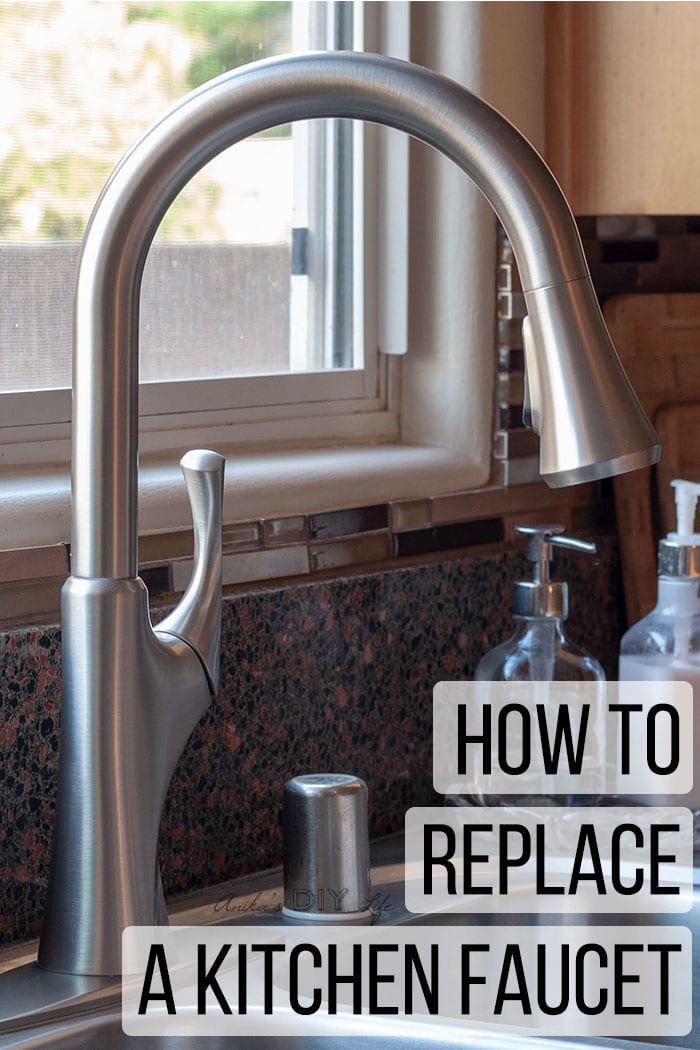
If you had told me a few years ago, I would be switching out faucets, I wouldn’t have believed you!
Building furniture and painting rooms are one thing…
Dealing with plumbing and electrical has been something I have avoided…
Never say never because here I am, changing out the kitchen faucet!!
*** This post is sponsored by Pfister. All opinions are my own. ***
***This post contains referral or affiliate links. It is a way for this site to earn advertising fees by advertising or linking to certain products and/or services. Please read my full disclosure here ***
Replacing the kitchen faucet is an easy way to upgrade your kitchen quickly.
You can go from a basic faucet to a nicer-looking, functional, and convenient faucet in just a couple of hours.
We installed the Pfister Miri which has over the sink installation – which means that you don’t have to wiggle yourself under the sink to install the faucet!! (Of course, you will have to do that to remove the old faucet)
How to Pick a Kitchen Faucet?
There are many things to consider when picking a kitchen faucet –
- Spout height and reach – You want to make sure that the faucet extends enough to reach all around the sink.
- No of holes in the sink – you can have 3 holes or 1 hole. The Pfister Miri is adaptable to the number of holes. It comes with a deck plate that can cover up the extra holes if needed.
- Single vs. multiple handles – You could have 2 separate handles for hot and cold or you can have a singe handle that makes water temperature adjustment so much easier!
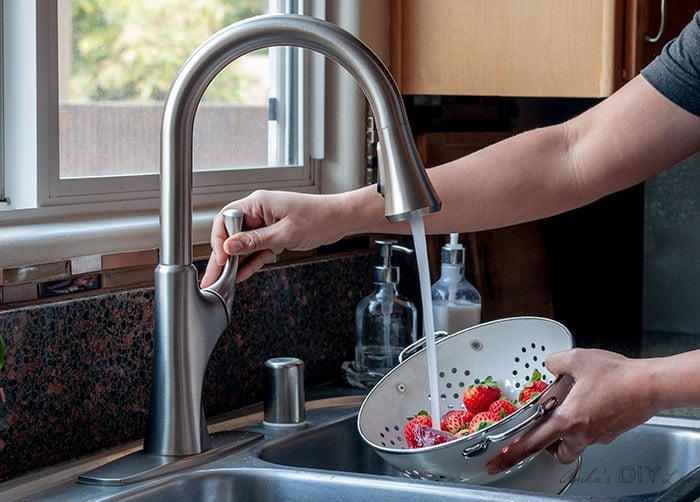
- Number of modes – Most modern faucets have a normal mode and a spray mode. The spray mode is great for lots of power and I love using it to clean vegetables
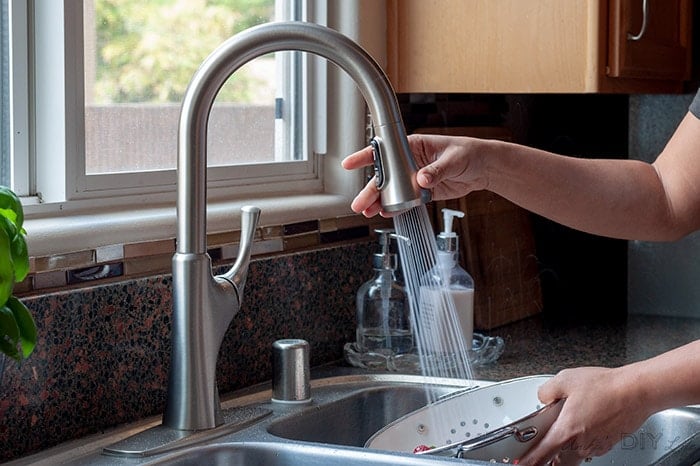
- Traditional vs. pulldown – Traditional sprayers have been known to be prone to leaks. Pull down faucets also make cleaning up a sink a lot easier. Plus, you can pull out the spout to fill up larger pots that may not fit under the faucet.
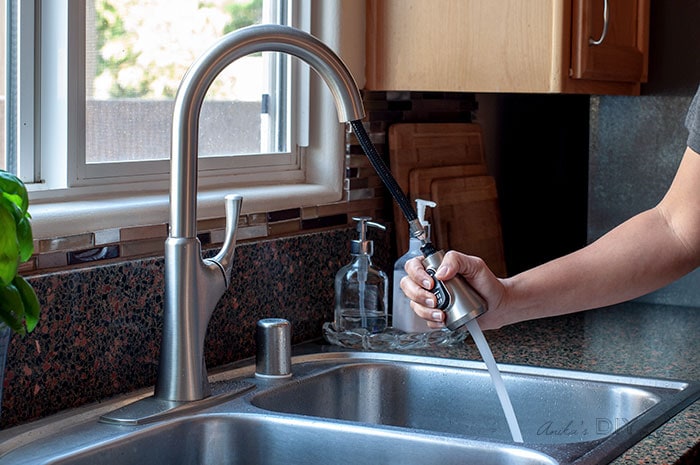
- Faucet finish (color, sheen etc) – This will depend on the rest of the kitchen finishes. However, protection from water marks will keep your faucet looking brand new. The Pfister Miri Kitchen faucet has Spot Defense which resists water marks!
How Much Does It Cost to Put in a New Kitchen Faucet?
Changing a kitchen faucet is a very easy DIY job.
Don’t let it intimidate you!
If you hire it out, you might end up paying $150-$200 to the handyman in addition to the cost of the faucet. By changing it yourself, you can get it done for just the cost of the faucet!
Is It Hard to Replace a Kitchen Faucet?
Trust me when I started looking into it, it seemed a bit overwhelming.
But when I actually got down to doing it, it was super quick and easy. It might need a bit of elbow grease to get the old faucet out depending on how old it is but once it was out, it was smooth sailing!
Especially, with the new Miri TopPFit kitchen faucet, where you don’t even have to crawl under the sink to attach it, things are SO SO easy!
So here is the old faucet.
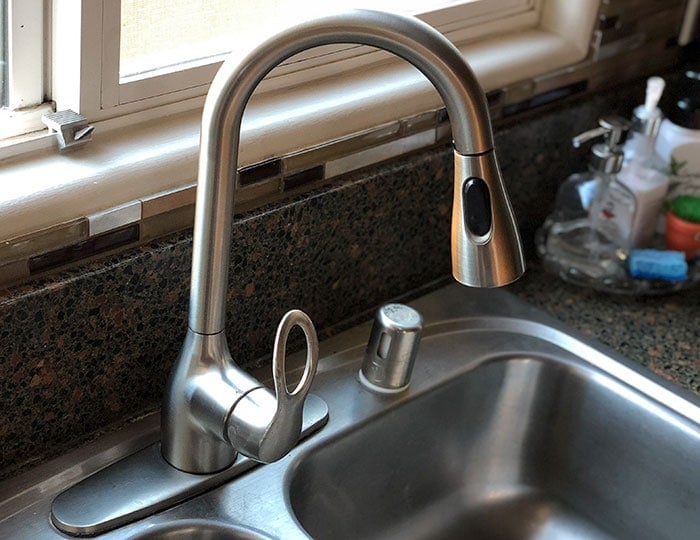
Not too bad…
There were a few little issues – like the cold and warm water was switched, the spout was crusty with deposits that refused to come off… it was getting a little harder to operate…
Nothing we couldn’t live without…but it was time for a change!
What Do You Need to Change a Kitchen Faucet
- New faucet (of course!)
- The Miri Kitchen Faucet by Pfister is a winner! It does everything we talked about before AND MORE!
- Wrenches in various sizes. A basin wrench is very useful here!
- Teflon tape( also called plumber’s tape)
- Flashlight for under the sink
- Old towel, buckets, and rags.
How to Replace Kitchen Faucet With a Sprayer?
Step 1 – clear under the sink area
- Remove everything from under the kitchen sink.
- Lay down an old towel so any water from the water lines doesn’t damage your cabinets.
- Keep buckets handy to catch any extra water.
How to Remove an Old Kitchen Faucet
Step 2 – disconnect the water supply.
- Turn off the water supply using the shutoff valves.
- Use pliers and adjustable wrenches to disconnect the water supply.
- If the hoses are marked, be sure to note and remember which one was what.
Mine weren’t marked plus the hot and cold were switched so I would be fixing that too!
Step 3 – remove old kitchen faucet.
Depending on the make and model of your old kitchen faucet, this can look different.
- Reach in under the sink and loosen the nut that holds the faucet in place.
- It can be hard to reach under the sink and use a wrench. There are various tools available to help with this. Research and buy something that will work with your faucet. I ended up buying a tool specifically meant for my style of faucet.
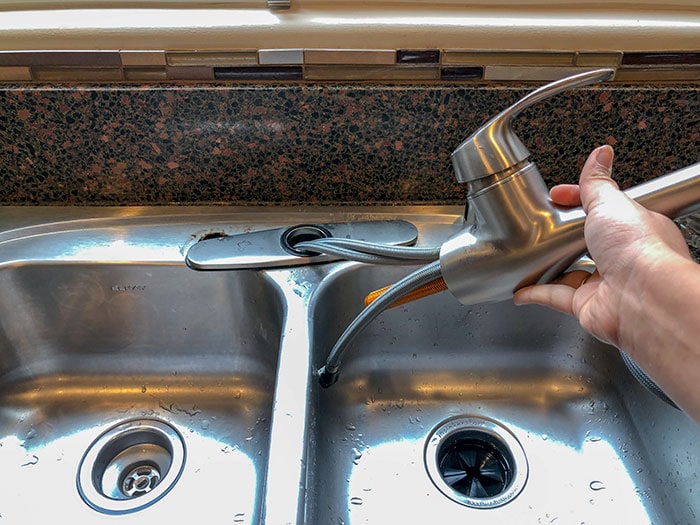
- Once the old faucet is out, clean up the entire area to remove all the gunk and years of deposits. This is one of my favorite cleaners for heavy duty cleaning like this.
How to Install a New Kitchen Faucet
Once you have the old faucet out, the new Pfister Miri kitchen faucet makes installing a new faucet as easy as it can be!
It has a new TopPfit above-the-sink installation technology which means it installs from above the sink!!!
You don’t need to go under the sink to install it – genius!!
Before installing the faucet, be sure to read the manufacturer’s instructions.
Step 4 – install the new faucet
- Start by lining up the deck plate if you have three holes in the sink like mine. If you only have one hole, you don’t need the deck plate.
- Drop all the tubes hanging from the faucet into the hole.
- There is a metal bracket which you hold vertical as you drop it in. This is the bracket that holds the faucet in place once tightened.
Step 5 – tighten the faucet
The Miri faucet has this genius new technology where you don’t need to go under the sink to tighten the faucet!
Can I get a high five?!
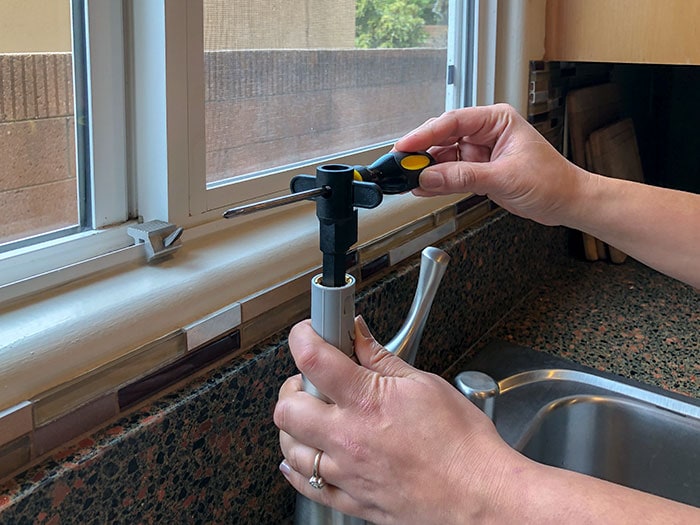
The TopPfit tool goes in from the top and you rotate it until the faucet is snug against the sink.
As you crank it, the horizontal metal brace from step 4 works its way up towards the sink and tightens.
Step 6 – drop in the sprayer and connect it
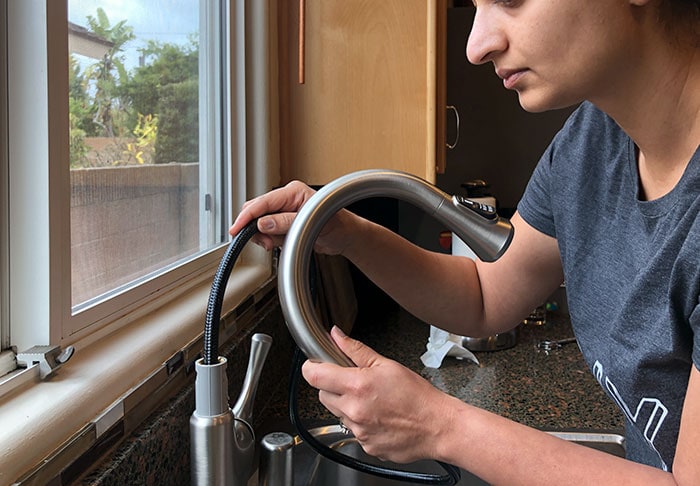
Thread the sprayer hose in through the faucet attachment and down under the sink.
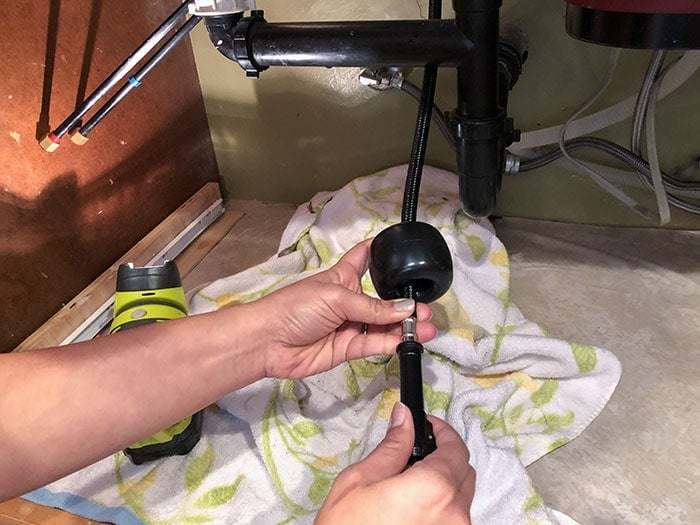
Under the sink, add the weight and connect the sprayer hose to the waterline with one click.
Step 7 – connect the faucet supply lines.
Time to connect the water supply lines. Since the hot and cold water lines were not marked in our original faucet, we used the splitter for the refrigerator connection to identify the cold water supply.
The Miri faucet water supply lines are color-coded and easy to identify.
How do you connect faucet supply lines?
- Use Teflon tape around the supply line and then screw on the water supply line.
- Tighten with a wrench.
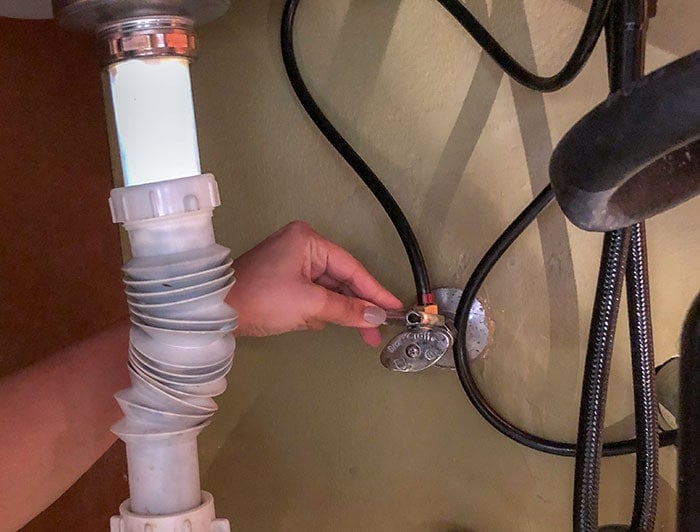
The Teflon tape helps lubricate the joint and keeps it from seizing.
Step 8 – turn on the water and enjoy!
Be sure to test to make sure there are no leaks from the water connections.
If there are leaks, check to see if the water connections are tight.
Note: Be sure not to over-tighten. That can cause the connections to crack in the future too!
That’s it! There is a new kitchen faucet!

The Miri faucet also comes with a soap dispenser too and I so wish we had an extra hole in our sink for it. I did toy with the idea of making a new hole but unfortunately, there isn’t any space around the sink.
In summary, if you are looking to replace your kitchen faucet, definitely check out the Pfister Miri kitchen faucet.
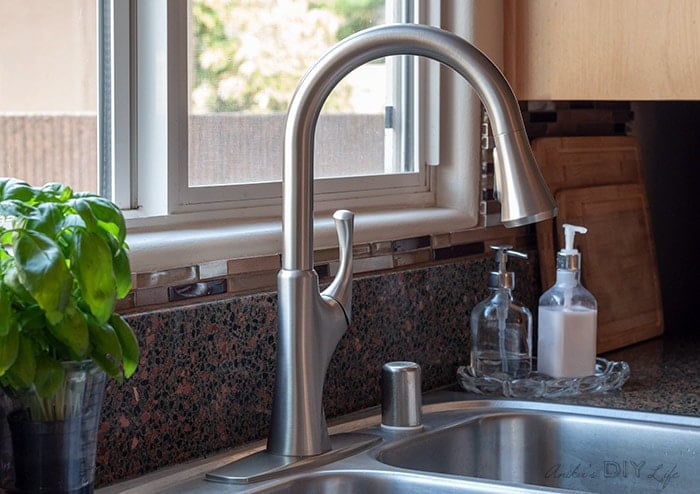
You won’t believe how easy it is to install it! Go ahead and do it yourself!
If I can do it, so can you!!
You might also like –
[mv_create title=”How To Replace A Kitchen Faucet” type=”diy” key=”32″]
Anika's goal is to inspire and empower beginners with woodworking, DIY, home improvement, and home decor ideas.
She wants everyone to unlock their creative potential and experience the feeling that comes with making something. Nothing feels better better than seeing something and saying "I can make that!"









It’s nice that the supply lines come with it because I always have to replace those.
My problem is the water valve is usually locked up because it hasn’t been shut off in years. The joys of owning an old house!
Oh boy, that IS a big job. It does appear that it can be done, but my golly, my husband would tell me not to touch plumbing, I am just a little person with weak hands and no plumbing experience! Come to think of it, my husband tells me not to try a lot of DIY projects… how does your husband react when you think of new projects?
Regards,
Honestly, he wasn’t very excited when I told him I was going to change it 🙂 But now he thinks differently. Ha!